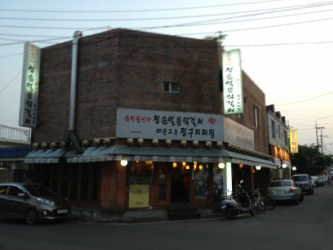 When you're heading out for a bite to eat and a drink it can be difficult to find a place where a vegetarian can partake in the bar food. This restaurant has a couple of options which is why I'm a fan of it. I'm not quite sure of this small restaurant's real name but it is affectionately called "the Omija Makgeolli place" by the foreign community. Located in Jeomchon's "new downtown" it sits across from Sleepless in Seattle on a relatively quiet street. The restaurant is known for offering omija makgeolli, a type of rice wine flavored with the local omija berry, served in a tea kettle. The restaurant has a variety of bar-type foods including a few vegetarian offerings which makes it an ideal place (for me at least) for group outings. Grilled tofu ( 두부구이/dubu gui) and sesame leaf jeon (깻잎전/kkeonipjeon) are the two dishes that I eat at the restaurant. Both are served with a small bowl of soy sauce mixed with scallions, garlic and hot peppers. If you don't mind fish sauce in your food you also have the option of dubu kimchi and kimchi jeon. There are numerous other items on the menu for the meat eaters in the group as well.  I do not know the exact location of the restaurant but the star on the map should give you a good idea of the location.
From the Jeomchon bus station/Home Plus area - walk down 당교로 (Dang Gyeo-Ro) which is the main road in Jeomchon. Turn right at the first road past Cafe Bene. Walk up two blocks and you will see the restaurant on your left. Sleepless in Seattle is on the right across the street. The restaurant is known for omija makgeolli, a type of Korean rice wine that is flavored with the local omija berry. Like most restaurants in Korea banchan is served with the alcohol but you are still expected to order food (anju). The menu has a variety of dishes including several different types of jeon (Korean pancakes) in addition to tofu, squid, etc. Prices are reasonable - grilled tofu is approximately 4-5,000 won and jeons are about the same price. I am not sure exactly how much a kettle of makgeolli costs but people are always pleasantly surprised the bill is so low when we leave.
0 Comments
We nearly passed up this restaurant for another meal at Oh Ge Sae Hyang because the latter is a bit less expensive. Dinner at 바루 (Baru) starts at 36,000 won for it's 12 course meal and only goes up from there. However, we decided to give it a try and were rewarded with a delicious meal that highlights the versatility and depth of flavor of Korean Buddhist temple food. For me this was one of the best meals I've had in Korea and the next time I return to Seoul I hope to return to Baru and try one of their other set meals. Below are pictures of the meal - unfortunately I neglected to takes photos of 2 of the courses - a seaweed broth and dessert which consisted of dehydrated fruit and a colorful custard like substance. 바루 - Directions 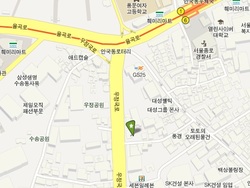 Baru
Temple Stay Building, 5th Floor, 71 Gyun Ji Dong, Jongno-Ku, Seoul Telephone: 02-2031-2081 To get to Baru take the red line (line 6) to Anguk and leave via exit 1. Upon ascending the stairs walk straight past Insadong-gil and a small plaza. Take a left on Ujeong-guk-ro and walk on the left hand side of the road. The restaurant is in the temple stay building directly across from the Jogyesa Temple. The first floor appears to be an information center or showroom connected to the temple. The restaurant is on the 5th floor. There is a simple buffet on the 2nd floor. The restaurant has both traditional and Western seating. It is a beautifully simple yet elegant dining space. There are a variety of set menus - a 10 course meal is available for lunch for 25,000 won. The least expensive dinner course is the 12 course meal for 36,000 won. There is also a course for 50,000 won and another for possibly 75,000 won. A pitcher of water is provided at your table at the beginning of dinner service but you are able to order additional drinks including tea. These beverages range from 15,000 won to 50,000 won. The restaurant is run by a nun associated with the Jogyesa order therefore the food is not only vegan but from what I understand does not include garlic nor onion. It is advised to make reservations but when we arrived at 5:30 we were able to make a reservation for 3 people for that same day at 6pm and this was on the same day as the Lotus Lantern festival at the temple across the street. 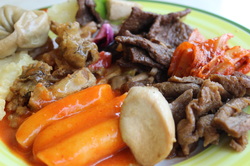 After living in Korea for 8 months I finally had my first experience at Loving Hut, an international chain which offers up an array of vegan food. I first heard about this Loving Hut location on the Seoul Veggie Club's facebook page (a helpful page locating vegetarian restuarants in Seoul if you can get past the shockingly awful elitism and animosity some members direct towards meat eaters and even other vegans and vegetarians who do not share their very narrow point of view on all things veggie). This was my first opportunity to eat at a veggie friendly restuarant since I last visited Seoul in December and so I decided to go all out. The restuarant offers a vegan buffet with a large variety of Korean and international dishes and I was determined to try just about a little bit of everything. I crowded my plate with ddoekboki, japchae, kimchi, mandu, sushi and a slew of other dishes. As with most buffets the food was hit or miss - some of it was delicious so I made sure to grab a bit more when I returned to the buffet lines, others were awful and sat barely eaten on my plate. One thing I found interesting about the buffet was the abudance of faux meat - replicas of beef and pork made from soy. Most added a meaty texture to the dish but not the taste of meat itself. Overall the food was tasty but not something I would eat frequently because it wasn't necessarily healthy. Most of the food was laden with sodium and after eating there I felt sluggish but very full and satisfied. I hear each Loving Hut is a bit different from the others so I'll have to visit more LH restaurants for comparison. Loving Hut Achasan - Directions 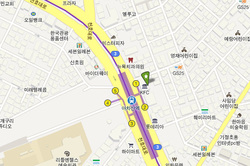 143-200, Gwangjin-gu, Gueui-dong, 53-10
SeoulSouth Korea 143-200 Telephone: 02-453-2112 This Loving Hut is conveniently located directly next to Exit 1 of Line 5 (Purple line). As you ascend the stairs of exit 1 look to your right and inside the building you'll see a stair case leading to the restaurant on the 2nd floor. The restuarant is quite spacious and so it would be ideal for large groups. It's very basic with rows upon rows of tables and chairs but two of the four walls are windows so it's a very sunny and cherry place. We arrived a bit after 1pm on a Saturday afternoon and it was not crowded. The food on the buffet was fresh and they even brought out more food during the hour we were there. In addition to the hot food on the buffet there was salad, fresh fruit, desserts and non-alcoholic beverages. There was a little chef's station with a cook standing there but I am not sure if you can special order food or he was there to ensure that there were sufficent skewers of grilled vegetables. At the entrance of the restaurant is a small section which has a variety of vegetarian food for sale including veggie-friendly ramyeon and packages of soy meat. Lunch on a weekend cost approximately 12,000 won (I also bought a package of soy meat so I'm not positive that's the exact amount). When I went they also accepted bank cards. I heard this Loving Hut is owned by the Taiwanese religious organization as the vegan restaurant Oh Se Gae Hyang which I will review next. Just about everyone who says it's easy to be a strict vegetarian (avoiding all meat, fish, etc) in Korea either 1) never eats out, 2) unknowingly eats a lot of meat products when he goes out to eat (kimchi isn't vegetarian, neither is ddeokboki or most juks) or 3) lives in or around Seoul. Being a vegetarian in Korea can be limiting especially when you want to go out to eat with friends but you have a lot more options in Seoul. Seoul is a major city with a population over 10 million people. It has a variety of ethnic restaurants which even if not Indian you have a good chance of finding at least one vegetarian entree (or one that could be easily adapted). It also has a variety of vegan restaurants - my preferred restaurant of choice when I go out to eat because there's no chance of fish in any form in the food. Frequently these vegan restaurants are associated with Buddhism - either directly connected to a temple or Buddhist organization or started by a former monk. 오세계향 (Oh Se Gae Hyang) is one of those restaurants. It is associated with a Taiwanese Buddhist organization and offers a variety of contemporary Korean dishes that are completely free of animal products. Our order of ssambap (faux pork which you wrap in lettuce leaves with rice and a few other sides), steamed pumpkin and dumplings came out with banchan, small bowls of fresh or fermented vegetables including kimchi and lotus root in a sweet soy sauce glaze. There was more than enough food for two people and we both left satisfied and very full. Everything was tasty and I especially enjoyed the dumplings because they're something I rarely get to eat as a vegetarian. 오세계향 - Directions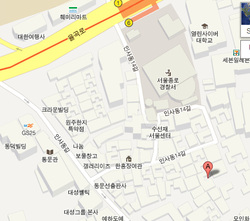 Oh Se Gae Hyang
Insa-Dong 12 Gil, 14-5 Jongno-gu, Seoul Telephone: 02-735-7171 Oh Se Gae Hyang is located off of the ever popular road, Insadong-Gil and is easily walkable from Gyeongbuk Palace, so it's very convenient for tourists and locals. To reach the restaurant take the train to the Anguk stop of the Red line (line #8) and leave from exit 6. Walk straight ahead until you come to Insadong Road, a crowded area with a plethora of restaurants, souvenir shops and other stores. Walk south on the left hand side of the road until you see 12 길. It is a small street and can be easily missed so look for small blue street signs. Turn left onto the street and the restaurant is at the very end of the road - the map pictured isn't quite accurate but it gives you a general idea. The restaurant has traditional Korean style seating so you sit on the floor along low wooden tables. You need to remove your shoes once in the entry way of the restaurant and store them in the cabinets on your right. The restaurant has few frills and service is very matter of fact. The prices are very reasonable not only for the location but for vegan cuisine, most entrees are 10,000 won or less. 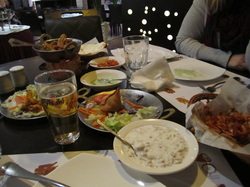 Indian restaurants are a god-send for vegetarians abroad ~ you're pretty much guarenteed at least a couple of veggie friendly dishes on the menu. Also, if you explain to the waiter that you're a vegetarian he or she will recommend dishes that exclude all meat (including fish) and eggs. On my first trip back to Seoul after making my home in Jeomchon my friend and I decided to have Indian food. Though I cook curries, rothi and chutneys pretty regularly in my apartment I enjoy the wide variety of dishes available at an Indian restuarant and the fact that I don't have to cook the food myself. Itaewon, a neighborhood in Seoul with an abundance of foreign restaurants and stores, has a few different Indian restaurants and so it was difficult to pick one. Since we were shopping at the International Market which is run by a man from the subcontinent, I asked for his recommendation and he directed me to Ashoka. We headed to the restaurant after stocking up on a variety of spices at the store and arrived at the restaurant a bit after 8, making up one of three only tables of customers there. The restuaurant is located on the 3rd floor of the Hamilton Hotel. It's a large spacious restaurant that provides an elegant but comfortable ambiance. The menu offers a wide variety of appetizers, soups, curries, rice dishes, flat breads and the like. My friend and I were quite hungary and craving rich and spicy food ordered an abundance of dishes to share including a dry curry, samosa, pakora, papad, yogurt, naan, paratha, gulab jamun, kulfi and a glass of Indian beer. Sadly we realized as we began to try bites here and there of the different dishes that the food was mediocre at best, it was too greasy and lacked the depth of flavor I had come to expect from Indian food. I had hoped that dessert might save the meal but my kulfi was freezer burnt while the doughy balls in my friend's gulab jamun had been literally burnt. The total for dinner came out to about 55,000 won ($50). Sadly, I don't think I'll give Ashoka another chance since there are many other Indian restaurants in Itaewon and throughout Seoul so I'll keep looking for delicious Indian food in Korea. Ashoka - Directions 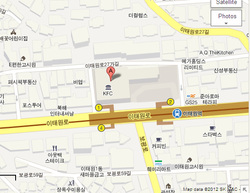 Ashoka Indian Restaurant
119-25 Itaewon-dong, Yongsan-gu, Seoul Telephone: 2-792-0117/796-0855 Ashoka is at the Itaewon stop (brown line/line 6). Use exit 1, you will come out in front of KFC. The restuarant is in the Hamilton Hotel to the right of KFC, set back from the main road. It is on the 3rd floor. The restuarant has a large menu with a variety of meat and vegetarian dishes including popular Indian dishes like tandoori chicken, chana masala, biryani, chicken tikka masala, samosa, etc. Vegetable curries are around 10,000-15,000 won, curries with meat are more expensive. The restaurant's website is www.ashoka.co.kr Sadly I recently discovered this restaurant in Insa-dong, Seoul is closed. It's a shame because this cozy restaurant had tasty and affordable vegetarian food along with some of the most delicious tea I've ever had. 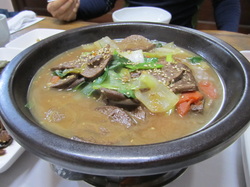 On my latest adventure to Mungyeong Saejae I ran into a teacher from Mungyeong Technical High School. He and his wife were helping out friends at their apple booth. They offered me a ride home and as we drove back to Jeomchon they invited me to dinner. Since all the teachers eat lunch together it is well known that I am a vegetarian. Their first restaurant choice was a tofu restaurant in a neighboring town but it was closed. So, we ate at 백련지, loosely translate as White Water Lily Lake. Though at first I was a bit doubtful there would be much for me to eat his wife ordered a variety of dishes and when they came out they appeared to be completely meat free! A large ceramic bowl full of boiling broth and what appeared to be thinly slices of beef in fact was a bowl of thin mushrooms. The rest of the dishes were an assortment of fresh vegetables, noodles and tofu along with a variety of banchan - in this case fermented vegetables such as lotus root and bean sprouts. I was so excited to be able to actually eat the food around me that I sampled a bit of everything. It was an incredibly delicious meal! 백련지 - Directions 백련지
169-14 Guhyang-ri, Hamchang-eup, Sangju-si, Gyeongsangbuk-do, South Korea +82 54-541-0203 백련지 is near Jeomchon (in the administrative district of Mungyeong-shi) in the small town of Hamchang. The restaurant is easy to get to - simply take a a taxi from the Jeomchon bus station to Hamchang's bus station. The ride is about 5 minutes and costs approximately 3,000 won. It is possible to take the bus but the cost of the bus for two people is about the same price as a taxi. The restaurant is across from the bus station. It has a gravel parking lot in front of it and a variety of plants on the steps. The restaurant has a few set courses, of which at least one is vegetarian. Be sure to explain to your server exactly what you do and don't eat. The first time I went with a Korean couple who explained that I didn't eat any meat including fish and we received meat-free food (though in hindsight I wonder if the kimchi was really vegetarian or if it had some sort of fish sauce in it). The second time I went with other foreigners and we were not as clear and some of the "vegetarian" food had fish in it. Meals are a bit more expensive than a typical Korean restaurant - around 20,000 or more won. 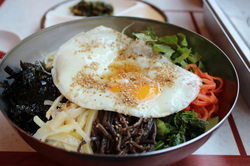 비빔밥 (bibimbap) is the first word I learned to read in Hangeul, the writing system for the Korean language. Bibimbap consists of a bowl of rice, a mixture of vegetables and a spicy chili sauce. Sometimes it has thin strips of egg, a fried egg or meat thrown in for good measure. Its a tasty and hearty dish that's popular throughout Korea. Every town has at least one shop which will throw together bibimbap for you. Since bibimbap is an ubiquitous dish that can be easily adapted for veggies it is ideal for the vegetarian or vegan traveler.
From my limited experience eating out bibimbap is typically meatless however, when ordering the dish it wouldn't hurt to tell the waitstaff you'd like a vegetable bibimbap (yachae bibimbap) or without meat. Since I'm still learning Korean I simply say "bulgogi apseyo" and hold my arms in an "x". If you're a vegan or lacto-vegetarian you can ask them to withhold the egg. Just be careful of any banchan (side dishes) like kimchi provided at the restaurant because it's likely there is fish sauce in it. Bibimbap typically costs around 5,000 won so it's rather cheap as well. Buddhist temples also typically serve a complimentary bibimbap to visitors on the Buddha's birthday. 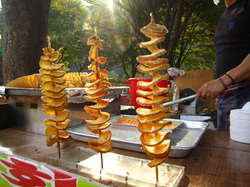 One thing I love about festivals is the food - bite sized pieces of food which are as incredibly flavorful as they are unhealthy. Many, if not most, types of festival food are served on a stick - and eating food on a stick is for some reason more than fun than eating it any other way (this was confirmed by my classmates in Japan last year). So, imagine how thrilled I was when I found something at a festival that I could eat that is as greasy as it is good - potato on a stick. It sounds simple enough, and honestly it is, it's a potato which was has been sliced into a thin ring, rolled in batter and then deep fried before getting a liberal coating of the topping of your choice - powdered cheese and bulgogi (from what I gather bulgogi is simply a mixture of spices used in bulgogi and not actually meat itself). Now while my friends munch on sticks of grilled meat I can enjoy my potato (I'm not being facetious, my friend Kate can attest to how much I loved my potato stick). I also found out that Mungyeong is famous for omija, a small red berry which is added to juice, tea and alcohol in the area. It's prevalent at local festivals and is quite tasty, the perfect accompaniment to my potato stick.
|
| Mindy in the City |
|






 RSS Feed
RSS Feed